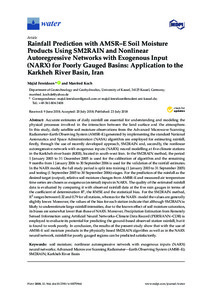| dc.date.accessioned | 2018-08-20T16:05:16Z | |
| dc.date.available | 2018-08-20T16:05:16Z | |
| dc.date.issued | 2018-07-23 | |
| dc.identifier.issn | 2073-4441 | |
| dc.identifier.uri | urn:nbn:de:hebis:34-2018082056200 | |
| dc.identifier.uri | http://hdl.handle.net/123456789/2018082056200 | |
| dc.description.sponsorship | Gefördert durch den Publikationsfonds der Universität Kassel | |
| dc.language.iso | eng | |
| dc.rights | Urheberrechtlich geschützt | |
| dc.rights.uri | https://rightsstatements.org/page/InC/1.0/ | |
| dc.subject | soil moisture | eng |
| dc.subject | nonlinear autoregressive network with exogenous inputs (NARX) neural networks | eng |
| dc.subject | Advanced Microwave Scanning Radiometer—Earth Observing System (AMSR–E) | eng |
| dc.subject | SM2RAIN | eng |
| dc.subject | Karkheh River Basin | eng |
| dc.subject.ddc | 500 | |
| dc.title | Rainfall Prediction with AMSR–E Soil Moisture Products Using SM2RAIN and Nonlinear Autoregressive Networks with Exogenous Input (NARX) for Poorly Gauged Basins: Application to the Karkheh River Basin, Iran | eng |
| dc.type | Aufsatz | |
| dcterms.abstract | Accurate estimates of daily rainfall are essential for understanding and modeling the physical processes involved in the interaction between the land surface and the atmosphere. In this study, daily satellite soil moisture observations from the Advanced Microwave Scanning Radiometer–Earth Observing System (AMSR–E) generated by implementing the standard National Aeronautics and Space Administration (NASA) algorithm are employed for estimating rainfall, firstly, through the use of recently developed approach, SM2RAIN and, secondly, the nonlinear autoregressive network with exogenous inputs (NARX) neural modelling at five climate stations in the Karkheh river basin (KRB), located in south-west Iran. In the SM2RAIN method, the period 1 January 2003 to 31 December 2005 is used for the calibration of algorithm and the remaining 9 months from 1 January 2006 to 30 September 2006 is used for the validation of the rainfall estimates. In the NARX model, the full study period is split into training (1 January 2003 to 31 September 2005) and testing (1 September 2005 to 30 September 2006) stages. For the prediction of the rainfall as the desired target (output), relative soil moisture changes from AMSR–E and measured air temperature time series are chosen as exogenous (external) inputs in NARX. The quality of the estimated rainfall data is evaluated by comparing it with observed rainfall data at the five rain gauges in terms of the coefficient of determination R2, the RMSE and the statistical bias. For the SM2RAIN method, R2 ranges between 0.32 and 0.79 for all stations, whereas for the NARX- model the values are generally slightly lower. Moreover, the values of the bias for each station indicate that although SM2RAIN is likely to underestimate large rainfall intensities, due to the known effect of soil moisture saturation, its biases are somewhat lower than those of NARX. Moreover, Precipitation Estimation from Remotely Sensed Information using Artificial Neural Networks–Climate Data Record (PERSIANN–CDR) is employed to evaluate its potential for predicting the ground-based observed station rainfall, but it is found to work poorly. In conclusion, the results of the present study show that with the use of AMSR–E soil moisture products in the physically based SM2RAIN algorithm as well as in the NARX neural network, rainfall for poorly gauged regions can be predicted satisfactorily. | eng |
| dcterms.accessRights | open access | |
| dcterms.bibliographicCitation | In: Water. - Basel : MDPI. - 2018, 10(7), 964, 1-15 | |
| dcterms.creator | Fereidoon, Majid | |
| dcterms.creator | Koch, Manfred | |
| dc.relation.doi | doi:10.3390/w10070964 | |

